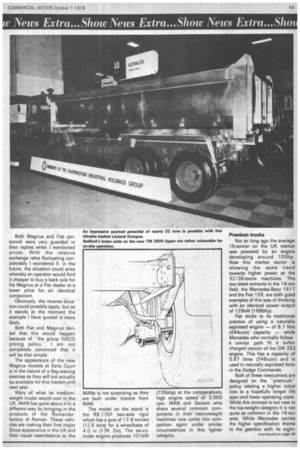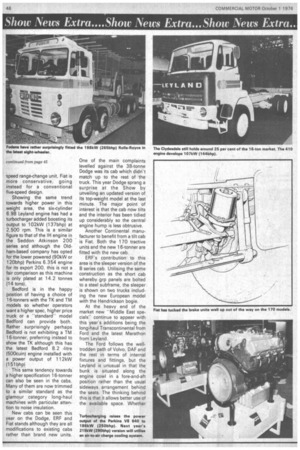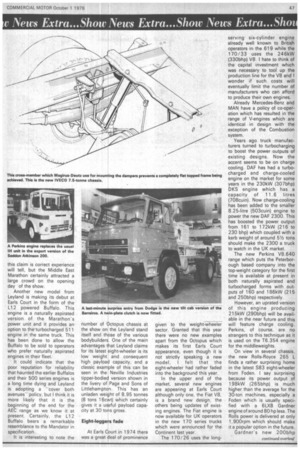MORE PUNCH FOR MIDDLE WEIGHTS
Page 46

Page 47

Page 48

Page 49

If you've noticed an error in this article please click here to report it so we can fix it.
by Graham Mon tgomerie
THIS YEAR'S Commercial Motor Show has seen the widening of the ranges marketed here by Continental manufacturers, and an increasing interest in automatic transmissions if not an increase in their availability.
In the 16-ton market, the trend is towards higher power, and higher specification trucks — following the example of a few years ago in the top-weight category.
With operators now accustomed to viewing Continental vehicles at the heavy end of the market — and in great numbers — this year's Show at Earls Court presents the first opportunity for people to view the European expansion into the lighter categories of the UK market.
One of the most interesting exhibits from a marketing as well as a technical point of view has been the Club of Four range from Saviem. The result of a design and production collaboration between the French company and Magirus-Deutz, Volvo and DAF, the trucks have been available in most countries in Europe behind one badge or another for some time now.
To market the Club trucks in England in a sector well served by Ford, Bedford, Leyland and Chrysler is a courageous step by Saviem who are celebrating 21 years as a company since the merger of Renault, Latil and Samua to form the Societe Anonyme de Vehicles Industrials et d'Equipements Mechaniques in 1955.
The Saviem J series as the Club trucks will be known in the UK cover the 9to 13-ton-gross Category although I learned at the Show that a non-hgv 7.5-tonne machine is on its way for the British market. All three of the J series models at nine, 11 and 13 tons use a naturally aspirated engine of 5.94 litres (335cuin) capacity which produces 112kW (150bhp) at 2,900rpm. For the heaviest
model a turbocharged version of the same engine is available with an extra 20 horsepower Saviem still persists in quoting power outputs to the useless SAE rating which bears no resemblance to the condition of an engine in its normal working environment.
As a rough guide the NA and TC versions in the J series will probably produce about 95 and 107kW (127 and 144bhp) respectively when rated to BS AU 141a. This puts it in more accurate perspective when compared with, for example, the 88kW (118bhp) of the Mercedes-Benz engine in the Chrysler (sorry, Dodge) Commando and the 73kW (98bhp) of the Bedford 330 unit.
I have driven various models from the Club manufacturers at different times outside the UK and while I was favourably impressed with the performance and slightly "up-marketspecification of the trucks 1 was intrigued to know what the asking price would be in the home market against such well entrenched opposition from the British manufacturers.
These prices have now been revealed with the cheapest being the JN 90 at £7,220 and the top model, the turbocharged JP 13C being listed at £8,470. Again using Bedford as a comparison, the nearest equivalent to the nine-tonner — the 8.5-ton TK 860 — is listed at around £4,400.
The gap narrows with the heavier models, however, with the equivalent Bedford costing around £6,000. This is a weight sector where the initial cost is given greater consideration before buying than, say, in the maximum-weight artic category and as such the Saviem J series will be under a fearsome handicap.
Well known in the UK for its heavy trucks, Magirus-Deutz is now represented further down the weight scale for the first time in this market. A lot of confusion has arisen in recent weeks over these trucks mainly because Magirus is a member of both the Club of Four and the International Vehicle Corporation better known as 1VECO. Just to set the matter straight the new Magirus-Deutz trucks are not Club of Four machines; they are the first results of the partnership with Fiat in IVECO.
In simple terms, although Magirus will probably not approve of the description, the new medium-weights are versions of the Fiat 55 and 75 models with the major difference being the use of a Deutz air-cooled engine in place of the water-cooled Fiat unit. .
One interesting difference is that the Magirus 90D 5.6 FL is plated at 5.6 tonnes while the basically similar Fiat OM 55 is plated at 5.8 tonnes even though the only difference is in the choice of power unit, each of which have equivalent power output anyway. Both Magirus and Fiat personnel were very guarded in their replies when I mentioned prices. With the relative exchange rates fluctuating considerably I wondered if, in the future, the situation could arise whereby an operator would find it cheaper to buy a back axle for his Magirus at a Fiat dealer at a lower price for an identical component.
Obviously, the reverse situation could possibly apply, but as it stands at the moment the example I have quoted is more likely.
Both Fiat and Magirus denied that this would happen because of "the group IVECO pricing policy." I am not completely convinced that it will be that simple.
The appearance of the new Magirus models at Earls Court is in the nature of a flag-waving exercise as they will not actually be available for this market until next year.
Wary of what its mediumweight trucks would cost in the UK. MAN has gone about it in a different way by bringing in the products of the Romanian factory of Roman. These vehicles are making their first major' Show appearance in the UK and their visual resemblance to the MANs is not surprising as they are built under licence from MAN.
The model on the stand is the R8.135F two-axle rigid which has a gvw of 12.8 tonnes (12.6 tons) for a wheelbase of 4.0 in (13ft 2in). The six-cylinder engine produces 101kW (135bhp) at the comparatively high engine speed of 3,000 rpm. MAN and Saviem who share several common components in their heavyweight machines now come into competition again under similar circumstances in this lighter category. Not so long ago the average 16-tonner on the UK market was powered by an engine developing around 100hp. Now this market sector is showing the same trend towards higher power as the 32/38-tonne machines. The two latest entrants in the 16-ton field, the Mercedes-Benz 1617 and the Fiat 159, are both good examples of this way of thinking with an identical power output of 125kW (168bhp).
Fiat sticks to its traditional practice of using a naturally aspirated engine — of 8.1 litre (494cuin) capacity — while Mercedes who normally follow a similar path fit a turbocharged version of the OM 352 engine. This has a capacity of 5.67 litres (346cuin) and is used in naturally aspirated form in the Dodge Commando.
Both of these newcomers are designed on the "premium" policy relating a higher initial cost to a hopefully longer life span ,and lower operating costs. While this concept is not new in the top-weight category it is not quite as common in the 16-ton area. While Mercedes carries the higher specification theme to the gearbox with its eight speed range-change unit, Fiat is more conservative, going instead for a conventional five-speed design.
Showing the same trend towards higher power in this weight area, the six-cylinder 6.98 Leyland engine has had a turbocharger added boosting its output to 102kW (137bhp) at 2,500 rpm. This is a similar figure to that of the IH engine in the Seddon Atkinson 200 series and although the Oldham-based company has opted for the lower powered (90kW or 120bhp) Perkins 6.354 engine for its export 200, this is not a fair comparison as this machine is only plated at 14.2 tonnes (14 tons).
Bedford is in the happy position of having a choice of 16-tonners with the TK and TM models so whether operators want a higher spec, higher price truck or a "standard" model Bedford can provide both. Rather surprisingly perhaps Bedford is not exhibiting a TM 16-tonner, preferring instead to show the TK although this has the latest Bedford 8.2 -litre (500cuin) engine installed with a power output of 112kW (151bhp) This same tendency towards a higher specification 16-tonner can also be seen in the cabs. Many of them are now trimmed to a similar standard as the glamour category long-haul machines with particular attention to noise insulation.
New cabs can be seen this year on the Dodge, ERF and Fiat stands although they are all modifications to existing cabs rather than brand new units. One of the main complaints levelled against the 38-tonne Dodge was its cab which didn't match up to the rest of the truck. This year Dodge sprang a surprise at the Show by unveiling an updated version of its top-weight model at the last minute. The major point of interest is that the cab now tilts and the interior has been tidied up considerably so the central engine hump is less obtrusive.
Another Continental manufacturer to benefit from a tilt cab is Fiat. Both the 170 tractive units and the new 16-tonner are fitted with the new cab.
ERF's contribution to this area is the sleeper version of the B series cab. Utilising the same construction as the short cab whereby grp panels are bolted to a steel subframe, the sleeper is shown on two trucks including the new European model with the Hendrickson bogie.
At the heavy end of the market new "Middle East specials" continue to appear with this year's additions being the long-haul Transcontinental from Ford and the latest Marathon from Leyland.
The Ford follows the welltrodden path of Volvo, DAF and the rest in terms of internal fixtures and fittings, but the Leyland is unusual in that the bunk is situated along the engine cowl in a fore-and-aft position rather than the usual sideways arrangement behind the seats. The thinking behind this is that it allows better use of the available space. Whether
this claim is correct experience will tell, but the Middle East Marathon certainly attracted a large crowd on the opening day of the show.
Another new model from Leyland is making its debut at Earls Court in the form of the L12 powered Buffalo. This engine is a naturally aspirated version of the Marathon's power unit and it provides an option to the'turbocharged 511 engine in the same truck, This has been done to allow the Buffalo to be sold to operators who prefer naturally aspirated engines in their fleet.
It could indicate that the poor reputation for reliability that haunted the earlier Buffalos and their 500 series engines is a long time dying and Leyland is adopting a "cover both avenuespolicy, but I think it is more likely that it is the beginning of the end for the AEC range as we know it at present. Certainly, the L12 Buffalo bears a remarkable resemblance to the Mandator in specification.
It is interesting to note the
ctopus chassis at the Leyland stand se of the various bodybuilder. One of the main advantages that Leyland claims for its latest eight-wheeler is its low weight and consequent high payload capacity, and a classic example of this can be seen in the Neville Industries tipper-bodied version shown in the livery of Page and Sons of Littlehampton. This has an unladen weight of 8.95 tonnes (8 tons 16cwt) which certainly gives it a useful payload capacity at 30 tons gross.
number of the show on itself and th Eight-loggers fade At Earls Court in 1974 there was a great deal of prominence given to the weight-wheeler sector. Granted that this year there were no new examples apart from the Octopus which makes its first Earls Court appearance, even though it is not strictly speaking a new model, I felt that the eight-wheeler had rather faded into the background this year.
In the upper end of the market, several new engines are appearing at Earls Court although only one, the Fiat V8, is a brand new design, the others being updates of existing engines. The Fiat engine is now available for UK operators in the new 170 series trucks which were announced for the Continent last year.
The 170/26 uses the long
serving six-cylinder engine already well known to British operators in the 619 while the 1 70 / 33 uses the 246kW (330bhp) V8. I hate to think of the capital investment which was necessary to tool up the production line for the V8 and I wonder if such costs will eventually limit the number of manufacturers who can afford to produce their own engines.
Already Mercedes-Benz and MAN have a policy of co-operation which has resulted in the range of V-engines which are identical in design with the exception of the Combustion system.
Years ago truck manufacturers turned to turbocharging to boost the power outputs of existing designs. Now the accent seems to be on charge cooling. DAF has had a turbocharged and charge-cooled engine on the market for some years in the 230kW (307bhp) DKS engine which has a capacity of 11.6 litres (708cuin). Now charge-cooling has been added to the smaller 8.25-litre (503cuin) engine to power the new DAF 2300. This has boosted the power output from 161 to 172kW (216 to 230 bhp) which coupled with a kerb weight of around 51/2 tons should make the 2300 a truck to watch in the UK market.
The new Perkins V8.640 range which puts the Peterborough based company into the top-weight category for the first time is available at present in both naturally aspirated and turbocharged forms with outputs of 160 and 186kW (215 and 250bhp) respectively.
However, an uprated version of this engine producing 215kW (290bhp) will be available in the near future and this will feature charge cooling. Perkins, of course, are no strangers to this technique as it is used on the T6.354 engine for the middleweights.
On view in several chassis, the new Rolls-Royce 265 L finds a rather surprising home in the latest S83 eight-wheeler from Foden. I say surprising because its power output of 198kW (265bhp) is much higher than the average for the 30-ton machines, especially a Foden which is usually specified with a 6LXB Gardner engine of around 80 hp less. The Rolls power is delivered at only 1,900rpm which should make it a popular option in the future.
Gardner's new 200bhp
continued overleaf




































































































































































